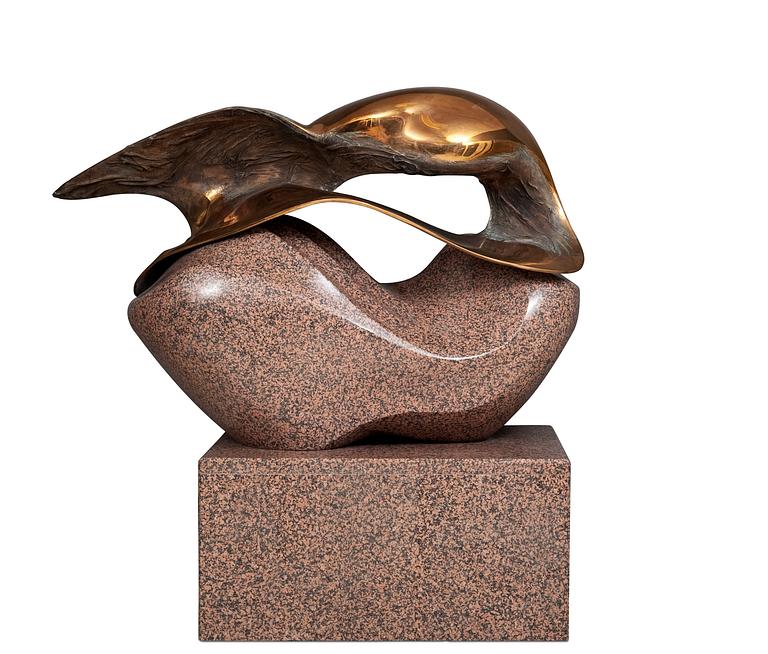Laila Pullinen
"GEE KAI DIASTEMA".
Sign. -93. Pyhäsalmi red granite and cast bronze 192x190x90 cm.
Provenance
Thomesto Trading Yhtiöt Oy, Helsinki
More information
”Ge Kai Diastema”, 1993 (Pyhäsalmi red granite and cast bronze)
Buyer: Thomesto Trading Yhtiöt Oy, Helsinki
First stages
The process behind Ge Kai Diastema was a long one. The sculptor, Professor Laila Pullinen (born 1933), has been developing the overarching theme of her sculptures since the 1960s.
”The first work in which I dealt with the recumbent theme using stone and bronze was ”Renessanssifiguuri” from 1963. It was first displayed at the opening of the Agora gallery in 1964 and afterwards in the Venice Biennale, from which it moved to the collection of the Sara Hildén Art Museum,” says Pullinen.
The work was made from Hyvinkää black granite. The material was running out and Pullinen only managed to get a block of it at the last moment. The scarcity of the material strongly influenced the composition of the work and, upon completion, left behind a desire to explore the theme in a slightly different way. Pullinen also wanted to recreate the same theme on a bigger scale.
”In Rome I had the opportunity to work with black Belgian marble. The size of the blocks prohibited me from treating the theme as I would have liked, but the material itself was so fascinating that I had to do it nonetheless. From the largest block I made ”Muisto Marilyn Monroesta” (1966), in which the gravitational theme is central. The work was moved straight from my exhibition in Milan to the collection of Mika Waltari in Helsinki.”
The next attempt took place in Italy, where Pullinen was lucky enough to get a slab of white marble marked ”esse esse” straight from the Carrara quarry. This material, too, was on the verge of running out. As in the cases of the previous works, the composition of the sculpture (Pro Patria, 1970) was again defined by the size and shape of the original block. It was first exhibited at Galerie Artek in 1971, at a solo exhibition in conjunction with the Helsinki Festival. After the exhibition the work was moved to the collection of the Pori Art Museum, and the gravity theme had to wait more than 20 years before its next chance to surface.
Thomesto
”The buyer (Thomesto/Kata Jouhki) contacted me concerning a sculpture for the entrance hall of their magnificent office building in red granite. The sculpture was to be made of the same red granite as the outer and inner walls of the building and, having seen the impressive dimensions of the room in question, the recurring theme that had nevertheless been left without a final fulfilment resurfaced in my mind,” analyzes Pullinen.
The Palin quarry found the suitable material – Pyhäsalmi red granite – and for the first time Pullinen was able to specify her desired dimensions before the block was hewn. The stone was initially worked at the study of the Association of Finnish Sculptors in Tattarisuo, where the necessary equipment for working such a large stone (initial weight approx. 3000kg) was available. It was then moved to Anjalankoski for completion. The bronze part was cast at the Kärkkäinen art foundry in Kellokoski.**
In the process of naming the work, Pullinen consulted two of her friends: Professor Paavo Castrén, with whom she was acquainted since her time spent in Rome, and the former Greek ambassador, Anastasios Sideris. The name stems from Hesiodos' description of the relationship between the earth mother Gaia (Ge) and Uranos, god of the sky. ”Gaia, the Earth Mother, first gave birth to an equal partner, Uranos, the sky carrying the stars, to cover all parts of herself that she might be a safe haven for the happy gods” (freely translated, Hesiodos ”Theogenia”)
The gravitation theme
When speaking of Ge Kai Diastema, Pullinen speaks of a ”gravitation theme”. The theme is central to her aesthetic philosophy - both in her stone and bronze sculptures and throughout all her works runs the central theme of the dualism of corpus and anima. Gravitation is born in the relationship between earth and the insubstantial. As a material, granite takes on the same role as the intentionally unrefined parts of bronze sculptures, approaching the figurative through draping or recognizeable shapes. It offers a point from which the reflective planes can begin reaching for insubstantiality whilst remaining anchored to themselves by virtue of their intrinsic nature. Thus is born gravity, an upward motion.
A thematically similar work, ”Taivaankaaren kannattaja”, was created a few years later. The name (roughly ”Supporter of the sky”) points the viewer in the right direction: it's a question of opposites, the gravitational pull of the Earth and the weightlessness of space; matter and the immaterial. The work perpetuates the cycle of two interconnected opposites (compare ying/yang), recreating itself as a Mobius band, twisting itself inside out and back again. The materials underline the dialogue between the heavy and the weightless: the heavy granite and the bronze polished to a mirror sheen seem to come from different worlds entirely, yet they are viscerally one.



























